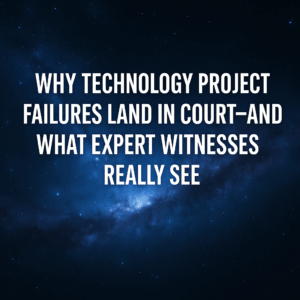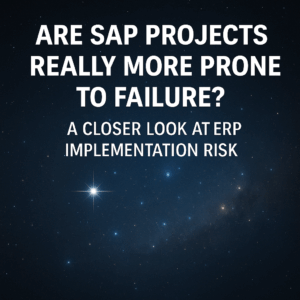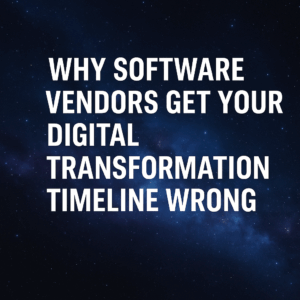In today’s rapidly evolving digital landscape, the success of a business’s digital transformation hinges on more than just the technology and tools it adopts. The human element – specifically, the project’s core teams or stakeholders – plays a pivotal role. When there’s a change in these project leadership roles, it presents a substantial risk to the entire transformational journey.
Table of Contents
ToggleWhat is Digital Transformation: A Brief Overview
Digital transformation has become a cornerstone for many businesses seeking to solidify their position in the market. As organizations strive to harness the power of technology to drive competitive advantages, they confront many challenges. From implementing cutting-edge cybersecurity protocols to ensuring that organizational culture adapts to these changes, the journey is fraught with potential pitfalls.
Amid these challenges, one risk that often flies under the radar is stakeholder turnover, which we see more frequently in our project restoration work. This article aims to shed light on this understudied risk and its implications.
Check out our Free Digital Strategy Framework to view all workstreams in DX projects:

Who are the Stakeholders in Digital Transformation?
To comprehend the ramifications of stakeholder turnover, we must first delineate who these stakeholders are. Within the digital transformation landscape, stakeholders span several vital areas:
- Senior Leadership: This group sets the tone, providing the overarching vision, direction, and the necessary resources.
- Middle Management: They are crucial in bridging the gap between strategy and execution, ensuring projects align with business objectives.
- Technical Teams: Comprising IT professionals, software developers, and other tech-centric roles, they are the driving force behind implementing digital solutions.
- End-users: Employees engaging directly with the new systems or processes daily.
- Customers: This is particularly relevant when transformations touch customer interfaces or systems.
- Transformation Partners: These could be third-party consultants, vendors, system integrators, and others who provide external expertise.
Each stakeholder brings a unique perspective and set of expectations, underscoring their collective importance in the transformation process.

Project Alignment at All Levels: The Keystone of Success
In project management, alignment is not just a complementary aspect; it’s a fundamental requirement. The term ‘alignment’ refers to the cohesion and harmonized understanding among team members, departments, stakeholders, and even the broader organization about a project’s goals, vision, methods, and desired outcomes. The importance of this alignment at all hierarchical and operational levels cannot be overstated.
Importance of Project Alignment at All Levels
- Unified Vision: With alignment, everyone from top-level management to junior team members clearly understands the project’s purpose. This unified vision prevents mixed messages, ensures consistent actions, and fosters a sense of shared purpose.
- Streamlined Decision Making: When everyone is aligned, decisions can be made more efficiently. There’s less back-and-forth because everyone is working from the same playbook.
- Optimal Resource Utilization: Alignment ensures that resources, both human and material, are deployed effectively towards a common objective, minimizing wastage.
- Efficient Conflict Resolution: Conflicts, when they arise, can be resolved more efficiently when there’s alignment. Team members and stakeholders can more easily find common ground when they share the same end goals.
- Enhanced Accountability and Responsibility: When there’s alignment at all levels, everyone understands their role, its significance in the larger scheme of things, and the consequences of their actions (or inaction).
Alignment at all levels ensures that a project moves forward like a well-oiled machine, where every part works harmoniously towards a shared goal, whether big or small. However, it’s a delicate balance. Any significant movement in resources can upset this equilibrium. While resource shifts are sometimes inevitable, understanding the potential risks they pose to alignment is crucial.
This knowledge enables organizations to take proactive steps, from comprehensive documentation and rigorous onboarding processes to stakeholder reassurances, ensuring that alignment is maintained or swiftly restored. In the intricate dance of project management, alignment is the rhythm that ensures every step is in sync.
Subscribe and listen to Transformation Ground Control Episodes
Diving Deeper: Why is Stakeholder Turnover a Concern?
The revolving door of stakeholders can significantly impede a digital transformation project for several reasons:
- Loss of Vision and Direction: Senior leaders often set the strategic direction. Their departure can cause a rift, with new leadership bringing different priorities or lacking the context of the initial goals. This divergence can set projects off course.
- Interruptions in Project Timelines: Digital transformation isn’t an overnight process. These projects have timelines that sometimes span years. A change in key stakeholders can lead to disruptions, causing delays or even leading to duplicated efforts due to miscommunication.
- Erosion of Institutional Knowledge: Long-standing stakeholders accumulate invaluable insights regarding the project’s intricacies. Their exit can result in losing this knowledge, making the path forward more challenging.
- Resource Re-allocation: New stakeholders might have different ideas about where resources (finances, workforce, or tools) should be directed, potentially diverting essential assets from critical areas.
- Increased Resistance to Change: New members might be less receptive to the proposed changes, especially if they weren’t involved in the foundational stages. Their resistance can hinder the project’s momentum.
External vs. Internal Stakeholder Turnover in an ERP Project
Enterprise Resource Planning (ERP) projects are monumental undertakings for any organization. They integrate various processes into a unified system, streamlining operations and facilitating information flow across the organization.
Given the complexity and scope of such projects, the involvement of many internal and external stakeholders is inevitable. Turnover among these stakeholders can introduce significant challenges. To understand the implications, let’s first delineate between external and internal stakeholders and then discuss the consequences of their turnover.
Internal Stakeholders: These are individuals or groups within the organization. They can include:
- Senior management or executive sponsor who provides vision and resources.
- Project managers are responsible for overseeing the ERP implementation.
- End-users who will utilize the ERP system in their day-to-day roles.
- IT teams who support and integrate the new system.
External Stakeholders: These are individuals or groups outside the organization vested in the project’s outcome. They can include:
- ERP software vendors.
- Third-party consultants who provide expertise.
- System integrators who are responsible for aligning the ERP system with other systems.
- Training or learning management providers who assist in upskilling the staff for the new system.
Turnover, whether internal or external, introduces uncertainty into an ERP project. Given the complexity and longevity of such projects, maintaining continuity and consistency is crucial.

The Turnover Project Cycle: Navigating the Waters of Project Management Change
Managing a project is akin to navigating a ship through a constantly changing sea. When the project manager (PM) at the helm changes, it can be likened to a shift in the captaincy while the ship is mid-journey. This transition has challenges and can often lead to what’s colloquially known as the “turnover project cycle.” Let’s delve into this cycle, its stages, and its implications for a project.
The Departure of the Existing PM
A PM’s exit can happen for organizational changes, better opportunities, or personal reasons. Their departure marks the beginning of the turnover cycle.
Once a new PM is identified, they undergo the onboarding process. This phase is about understanding the project’s current state, history, challenges, stakeholders, and more. Even the most competent PM will require time to grasp the nuances of a new project. As the new PM gets up to speed, certain decisions or actions may be postponed, leading to project delays.
After the initial onboarding, the new PM begins to operate at full capacity, making decisions and driving the project forward, such as course corrections. With fresh eyes, the new PM might identify areas of improvement or necessary changes, leading to adjustments in project direction.
The new PM may also need to re-establish trust and rapport with stakeholders, ensuring alignment and addressing concerns. As the incoming PM becomes more comfortable, they might introduce new methodologies, tools, or processes that benefit the project. However, no processes have an adjustment period, thus extending the timeline.
Implications:
- Extended Timelines: While some changes can streamline processes, implementing significant alterations can extend project timelines as the team adjusts.
- Risk Amplification: Each change introduces variables. If not managed correctly, these can amplify project risks.
- Team Dynamics: Changes can affect team dynamics, leading to potential resistance or the need for additional training.
The turnover project cycle is a significant challenge. The departure of a PM and the subsequent changes introduced by their successor can unsettle a project, extend its timelines, and amplify risks.
Organizations can mitigate these challenges by ensuring robust knowledge transfer processes, fostering open communication, and providing the new PM with the resources and support they need to succeed. While the waters of the turnover cycle are choppy, the ship can continue its journey toward its destination with careful navigation.
The Critical Role of Specialists: Navigating the Turnover of Subject Matter Experts in Complex Projects
In any major project, particularly those involving intricate processes and specialized knowledge like in production-heavy industries, the role of specialists or subject matter experts (SMEs) is paramount. These SMEs possess a deep understanding of specific areas of the project, often ones that are critical to its success.
The system integrator SMEs, for example, can bridge the gap between technical systems and practical applications in production environments. Their role is especially significant in the initial phases, where the groundwork is set and the project direction is defined.
But what happens when there’s a sudden turnover among these specialists? Let’s explore the potential ramifications and how they can significantly impact the project.
Let’s look at an example scenario we’ve seen on a recent client project. After weeks or months of briefing the SMEs about intricate processes, specific production nuances, and project objectives, their departure can result in a significant loss. Their accumulated knowledge encompasses the technical details and includes the reasons behind certain decisions, stakeholder dynamics, and potential challenges.
- Additional Time and Resource Commitment: With the exit of the initial SMEs, new specialists will need to be brought on board. This means the organization must invest additional time and resources to bring the new experts up to speed. This process involves transferring technical knowledge and understanding the project’s unique challenges, goals, and specifications.
- Risk of Misinterpretation and Errors: While the onboarding of new SMEs is crucial, it also comes with its set of challenges. Each expert will only interpret information differently. Despite being experts in their field, the new SMEs may interpret specific data, processes, or objectives differently from their predecessors. This divergence in understanding and approach can lead to errors, misalignments, or project setbacks.
- Potential Delays in Project Timeline: Every transition phase, especially one involving critical roles like SMEs, can introduce delays. Not only is there a pause as the new experts come in and get acclimated, but potential adjustments or corrections stemming from the new interpretations can also add to the project timeline.
The sudden departure of SMEs, especially after significant project milestones like the projection process, is undoubtedly a challenge. It underscores the importance of ensuring that knowledge transfer isn’t just limited to a few individuals but is documented and shared broadly. This way, while personal expertise is invaluable, individual departures only partially derail the project.
Moreover, organizations can investigate contractual measures or contingency plans with system integrators or partners to minimize the risk of sudden turnovers. Regular check-ins, feedback loops, and robust onboarding processes can also aid in smoother transitions. The key is to anticipate potential challenges and have mechanisms to navigate them effectively.
Strategies to Minimize the Impact of Turnover
While stakeholder turnover is an inevitable part of the corporate world, there are measures organizations can adopt to lessen its detrimental effects:
- Solid PMO Practice: A Third Stage, we call this Mission Control. Engage an independent, experienced, and technological agnostic expert leading the charge. These partners should be dedicated to your business goals only. Investing in this project advisory service is the insurance policy for your project.
- Robust Documentation: Maintaining comprehensive documentation – from project objectives and strategies to challenges encountered – ensures a smoother transition for incoming stakeholders.
- Backfill and Succession Planning: Foreseeing potential exits and having a plan for subsequent appointments can stave off disruptions.
- Inclusive Decision Making: Diversifying the decision-making process ensures the project isn’t overly dependent on a few individuals.
- Open Channels of Communication: Regular updates about the project’s status and any alterations can preempt misunderstandings and reduce resistance.
- Structured Onboarding for New Stakeholders: An efficient onboarding process can familiarize new stakeholders with the project’s history and objectives, mitigating potential risks.
Digital transformation, while promising a world of opportunities for businesses, requires meticulous planning, unwavering commitment, and consistent execution. The upheaval caused by stakeholder turnover can significantly disrupt this journey. By recognizing and proactively addressing this challenge, organizations can steer their transformation projects toward success, ensuring they harness the full potential of their digital endeavors.

Conclusion
Navigating a shift in project stakeholders or preparing for one? Let’s chat. You can reach me at kyler.cheatham@thirdstage-consulting.com for a casual discussion. Thoughts on this piece? I’d appreciate your insights!
I want to invite you to subscribe to our weekly podcast. You can ask questions live and join our journey towards industry transparency: https://www.thirdstage-consulting.com/podcasts/
Finally, I highly recommend downloading our latest 2024 Digital Enterprise Operations Report. It’s brimming with trends and top-notch strategies to ensure your project thrives.
Frequently Asked Questions:
What is project alignment?
Project alignment refers to the coherence and shared understanding among all involved parties—such as team members, departments, stakeholders, and even the entire organization—regarding a project’s goals, vision, methods, and desired outcomes. It ensures that all efforts, decisions, and resources are directed towards achieving common objectives. Proper project alignment facilitates efficient communication, streamlines decision-making processes, and fosters a sense of shared purpose and direction. It ensures that everyone, from leadership to individual contributors, is working in tandem toward the successful completion of the project, minimizing miscommunication, wasted resources, and conflicting priorities.
Why is alignment crucial in digital transformation strategy projects?
Alignment ensures everyone, from senior leadership to technical teams, shares a unified vision and understanding of the project’s objectives, strategies, and expected results. This promotes efficient decision-making, resource utilization, and conflict resolution.
Who are considered the key stakeholders in digital transformation?
Stakeholders include Senior Leadership, Middle Management, Technical Teams, End-users, Customers, and Transformation Partners like external consultants and vendors.
What challenges does stakeholder turnover present?
Turnover can lead to a loss of institutional knowledge, workflow disruption, a shift in project priorities, potential cultural mismatches, and increased costs.
How can resource changes threaten project alignment?
Resource changes, such as personnel or tools, can disrupt established rhythms, require realignment efforts, lead to a loss of critical project knowledge, and strain project budgets.
Why is the alignment of all levels in a project described as a “nuanced ballet”?
Because alignment ensures all components of the project work in harmony, much like dancers in a ballet, any significant change or misstep can disrupt the flow, requiring quick adjustments to maintain balance.
What proactive steps can organizations take to maintain alignment during resource shifts?
Comprehensive documentation, rigorous onboarding processes, and continuous communication with stakeholders are some methods to ensure alignment is either maintained or quickly restored.
How does stakeholder turnover affect costs in digital transformation projects?
Turnover, especially unplanned, can introduce expenses related to training new team members, investing in new tools, and reallocating funds from other essential areas.
How does alignment enhance accountability in digital transformation projects?
When there’s alignment at all levels, every individual understands their role, its significance, and the consequences of their actions, fostering a greater sense of responsibility and accountability.





